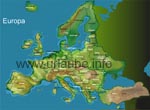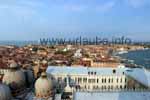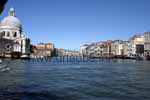General Information About Venice

Venice is indeed an Italian small city if one considers its number of inhabitants. But in reality, Venice is a significant world city with a big famousness that is somehow known by everybody, also if one has not been there. The same way a one associates the city Paris with the Eiffel Tower, with London the Big Ben or with Moskau the Kreml, the city Venezia is named in one breath with the famous gondolas and waterways. And of course, even as a person who has bever been there, one has already seen the world famous Piazza San Marco on TV and even if it was just for the reason that again, it was covered with water.

Venice belongs to those cities that one wants to have seen in any case. Finally, it is something special and very unique if there are no cars but ships driving through the city, when the main roads do not consist on asphalt but on water and when the houses are not standing on a dry ground but right on the saltwater.
But Venice of course offers much more than ships, gondolas and water streets. There are countless churches, thereunder such world famous ones as the San Marco Basilica, palaces and gorgeous buildings, nearly countless plazas and parks and of course a good dozen of partly excellent museums. But the actual totally fascinating thing of Venice cannot be described concretely: it is the possibility to promenade in a car-less city all over the huge labyrinth consisting on small streets and alleyways and passing thereby hundreds of small shops and probably buy one or two souvenirs or piece of clothes.
The History of Venice
Contrary to many other Italian cities, Venice was founded by the Romans. On the numerous islands in the Laguna Venetia, there were indeed some isolated fisherman living but the actual foundation of Venice is dated in the year 452, when at the time of the big migration period the Huns with their King Attila came to north Italy and spread out there. Being afraid of the intrusers, many inhabitants of northern Italy escaped to the lagoon and built there the first bridges and houses on piles.
Venice became increasingly bigger, island by island was made accessible and covered with buildings. In the 13th century, Venice grew to be a big economic power; Venice was called the "Queen of the Adria"; the Venetians were not only responsible for the movement of high quantities of goods, they also controlled the most important shipping lanes in the Mediterranean sea. Everywhere in the Mediterranean sea, the venetians founded some important trade branches. In the course of the time, the empire of the Venetians also developed further to the hinterland: cities as Padova, Verona and Vicenza also belonged to the territory of Venice as the island Cipre at the very south.
Venice mantained its power up to the 15th century; not until then, the Venecian power slowly started to disintegrate, when the spreading Ottoman took away the property they gained until then. In the course of the centuries, Venice even became the political football of international politics, belonged once to Italy, then to Austria, and also Napoleon once absorbed Venice. In the year 1866, Venice became again a part of the kingdom of Italy.
Venice Today - The City Decays
Only approximately 70.000 people still live in the lagoon city Venice. I say "still" because the number of inhabitants continuously decreases every year. With more than 10 millions of tourists every year, this is not noticeable to the visitors of Venice. Each second inhabitant of the city does indeed finance their live by the flood of tourists, but life is getting increasingly difficult and less comfortable for the inhabitants. One can imagine that it is better to live in a new concrete block on the mainland than on a small scungy old building in the oldtown.

Additionally, the prices for food highly arise, so that a normal food shopping is practically not possible any more. The number of the groceries decrease every year, but instead there are increasing numbers of shops selling from glass items to carnival masks everything what the tourists want. Thus, the local island inhabitants are increasingly forced to make the long trip to the mainland to do the shopping for their lifetime demand. But such a trip to the Terra Ferma equals a day excursion, as the public means of transportation are optimized for the tourists but not for the local people.
In Venice, not only the number of inhabitants decays but also the whole building mass and/or the whole city is on a shaky position. Every year, the city sinks deeper for one centimetre into the sea. Those who have a closer look at the wall coverings of one or two houses will see some deep cracks in the basic building structure. It happens with an increasing frequency that there is floodwater in the city, so that numerous streets and bridges are under water and one can only access the most important points of the city on temporary elevated footways.
Thus, go to Venice as long as the city still exists! On the other hand - the Leaning Tower of Pisa is also declared dead since long ago and these days, we were actually not allowed any more to drive a car, as currently, the last natural oil source is running dry...
A few Facts about Venice
The city area of Venice is of approximately 8 km², there are approximately 3000 little streets and alleyways that are connected with each other by more than 400 bridges. The houses are nor numerized per street the way we are used to it but rather have a kind of consecutive number within a city block/city district. There are approximately 150 channels that are partly so tiny that a narrow gondola barely gets through.

Venice is also connected with the main land by a bridge of a length of approximately 3 kilometres. On the 222 bridge archs, a four-lane motorway and also a four-lane railway-line runs. Thus, the north-western part of Venice is at a good three kilometres distance from the mainland; the south-eastern part is at a distance of barely 2 km from the Adrian Mediterranean sea (Golfo di Venézia).
Inthe lagoon of Venice (Laguna Véneta) there are in total approximately 120 islands that are partly communicated by some bridges. Three big and longish headlands protect the lagoon against the big sea. From the Venetian point of view, it is of course the Litorale di Lido the most famous and significant one. This longish sand beach island is a wonderful bathing paradise and there are enough boat trips to the lagoon-capital.

Back to the index Venice
Copyright: Patrick Wagner, www.tourist-guide.biz
|